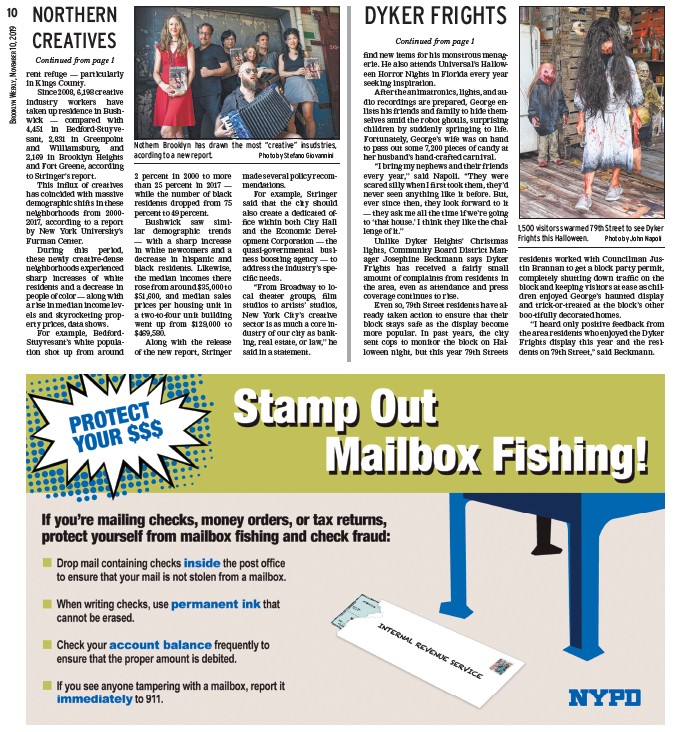
10
BROOKLYN WEEKLY, NOVEMBER 10, 2019
NORTHERN
CREATIVES Continued from page 1
fi nd new items for his monstrous menagerie.
He also attends Universal’s Halloween
Horror Nights in Florida every year
seeking inspiration.
After the animatronics, lights, and audio
recordings are prepared, George enlists
his friends and family to hide themselves
amid the robot ghouls, surprising
children by suddenly springing to life.
Fortunately, George’s wife was on hand
to pass out some 7,200 pieces of candy at
her husband’s hand-crafted carnival.
“I bring my nephews and their friends
every year,” said Napoli. “They were
scared silly when I fi rst took them, they’d
never seen anything like it before. But,
ever since then, they look forward to it
— they ask me all the time if we’re going
to ‘that house.’ I think they like the challenge
of it.”
Unlike Dyker Heights’ Christmas
lights, Community Board District Manager
Josephine Beckmann says Dyker
Frights has received a fairly small
amount of complaints from residents in
the area, even as attendance and press
coverage continues to rise.
Even so, 79th Street residents have already
taken action to ensure that their
block stays safe as the display become
more popular. In past years, the city
sent cops to monitor the block on Halloween
night, but this year 79th Streets
residents worked with Councilman Justin
Brannan to get a block party permit,
completely shutting down traffi c on the
block and keeping visitors at ease as children
enjoyed George’s haunted display
and trick-or-treated at the block’s other
boo-tifully decorated homes.
“I heard only positive feedback from
the area residents who enjoyed the Dyker
Frights display this year and the residents
on 79th Street,” said Beckmann.
rent refuge — particularly
in Kings County.
Since 2008, 6,198 creative
industry workers have
taken up residence in Bushwick
— compared with
4,451 in Bedford-Stuyvesant,
2,831 in Greenpoint
and Williamsburg, and
2,169 in Brooklyn Heights
and Fort Greene, according
to Stringer’s report.
This infl ux of creatives
has coincided with massive
demographic shifts in these
neighborhoods from 2000-
2017, according to a report
by New York University’s
Furman Center.
During this period,
these newly creative-dense
neighborhoods experienced
sharp increases of white
residents and a decrease in
people of color — along with
a rise in median income levels
and skyrocketing property
prices, data shows.
For example, Bedford-
Stuyvesant’s white population
shot up from around
Nothern Brooklyn has drawn the most “creative” insudstries,
acording to a new report. Photo by Stefano Giovannini
2 percent in 2000 to more
than 25 percent in 2017 —
while the number of black
residents dropped from 75
percent to 49 percent.
Bushwick saw similar
demographic trends
— with a sharp increase
in white newcomers and a
decrease in hispanic and
black residents. Likewise,
the median incomes there
rose from around $35,000 to
$51,600, and median sales
prices per housing unit in
a two-to-four unit building
went up from $129,000 to
$469,580.
Along with the release
of the new report, Stringer
made several policy recommendations.
For example, Stringer
said that the city should
also create a dedicated offi
ce within both City Hall
and the Economic Development
Corporation — the
quasi-governmental business
boosting agency — to
address the industry’s specifi
c needs.
“From Broadway to local
theater groups, fi lm
studios to artists’ studios,
New York City’s creative
sector is as much a core industry
of our city as banking,
real estate, or law,” he
said in a statement.
Continued from page 1
DYKER FRIGHTS
1,500 visitors swarmed 79th Street to see Dyker
Frights this Halloween. Photo by John Napoli